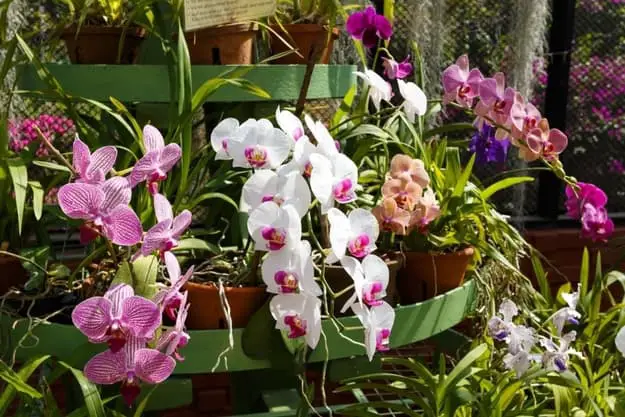Are orchids resilient?
Yes,Orchids are resilient and can survive most conditions, however, they prefer a specific temperature range and humidity levels that may not be met in your environment.
If you live in an apartment or have a home that doesn’t have the proper conditions, there are ways to make your orchid thrive despite the odds.
Orchids like temperatures between 65 and 80 degrees Fahrenheit. If you can’t provide such temperatures, you can keep your orchid cool by placing it on a windowsill during the day and moving it to a cooler place at night.
A good way to provide just the right amount of light is to place your orchid near a window with sheer curtains so that it gets the sunlight without being exposed to too much direct light.
Orchids also love humidity, so if you don’t live in a humid environment, you can use a humidifier or mist your plant daily with water from a spray bottle.
Orchids are pretty resilient plants and will survive under most circumstances as long as you care for them properly.
I like to think of orchids as resilient plants
I like to think of orchids as resilient plants. With the proper amount of care, most orchids can be coaxed back to life and are even able to produce beautiful blooms.
Orchid Resilience:
I often get messages from people who say they’ve killed their orchid(s). I don’t believe that! Orchids have a bad reputation for being finicky and difficult to grow, but they are actually some of the easiest flowering plants in the world.
A lot of people who say they’ve killed their orchid were probably growing it in an environment that was just too difficult to maintain.
For example, if you leave your orchid outside for a few days and it gets rained on, it might not be able to recover from that experience. But if you bring it indoors in a bright room and water it every few days, chances are good that your orchid will bounce back.
The reason I say this is because I’ve experienced it myself with my own orchids. I’ve left my plants outside for many days, sometimes weeks at a time without any care, and they would still grow back when I brought them inside again! This is one of the reasons why orchids are so popular with travelers –
They can thrive in many different temperatures and climates
In the past, orchids have gotten a bad rap as being finicky flowers that are difficult to grow and care for. In truth, they’re actually some of the most resilient plants in the world. They can thrive in many different temperatures and climates.
The U.S. Department of Agriculture (USDA) has categorized orchids into hardiness zones 10 through 12, which tells you how well the plants can withstand cold temperatures. Orchids can be grown both indoors and outdoors in many different parts of the country.
Orchids grow best in moderate temperatures between 65°F and 80°F during their growing season (spring through fall). It’s important to protect them from direct sunlight during this time to prevent leaf burn.
In winter, keep your orchid between 40°F and 50°F at night and 60°F to 70°F during the day. During this time, place your plant in an area with bright light but no direct sun .
They can also be very long-lasting
Orchids are long-lasting, beautiful flowers. From the family Orchidaceae, they come in a wide variety of shapes, sizes, and colors.
With over 25,000 species in total, there’s an orchid out there that’s right for every space. Their diversity, beauty, and interesting reproductive cycle have made them some of the most highly prized plants in the world.
They are also considered to be one of the oldest flowers on earth. Orchids are grown commercially for their cut flowers and for sale as potted plants.
You can make them a long-term part of your decor
Although they are considered temporary additions to a home, you can make them a long-term part of your decor.
When the flowers of your orchid have faded, it’s not necessarily time to toss the plant in the compost heap.
Orchids are a long-lived plant. With proper care, they can rebloom year after year.
The trick to getting your orchid to rebloom is to give it what it needs when it needs it and not water or fertilize if the plant is dormant. The leaves will appear yellowish or brownish and shriveled as the plant goes dormant, but that is normal.
When you see new growths start to poke out of the plant, you know it’s time to start taking care of the plant again.
Takeaway:
Yes, orchids are resilient.
Orchids are not only resilient, they are so resilient that they have become weeds in many places. They are almost impossible to kill, and they adapt quickly to whatever the environment throws at them.
The resilience of orchids comes from the fact that they are predominantly epiphytes (they grow on other plants), and they do not require much soil to survive and thrive.
They can be grown in a pot with some bark chips and this will be enough for them to grow and flower. They also have very limited water requirements and only need watering about once a week.
Another factor in the resilience of orchids is their ability to adapt to different environments. In their natural habitat, orchids will grow in the canopy of trees to reach light levels that suit them best.
In the home, orchids will grow towards light coming through windows and will rotate on their stem to ensure that all parts of the plant receive sufficient light for photosynthesis. If you notice your orchid bending towards a window, move it closer so it can catch more light.
Also Read: ESPRESSO ORCHID CARE | Ultimate Guide

